- 29 AOÛT
- INDI-UNI : 
PRE-INSCRIPTION : 15 Juin – 31 Août
PRE-REGISTRATION: June 15th - August 31st
- IRAN – 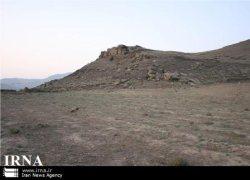 Affelle - A cairn wall belonging to the Parthian Empire (247 BC - 224 AD) in ancient Persia was discovered in northern Iran. A coin and a copper artifact of the medieval Islamic civilization were also found at the archaeological site in Nowshahr in Mazandaran province, the Iran Cultural Heritage, Handcrafts and Tourism Organization said. The Affelle archaeological site is about five sq km which had been used as a metal-melting shop in ancient Persia, director of the study team, Mohammad Ghamari Fatideh said. 'Pottery and other surface evidences showed the site dates back to the Parthian period,' the official IRNA news agency quoted the official as saying. The Parthian Empire was a major Iranian political and cultural power in ancient Persia.
Affelle - A cairn wall belonging to the Parthian Empire (247 BC - 224 AD) in ancient Persia was discovered in northern Iran. A coin and a copper artifact of the medieval Islamic civilization were also found at the archaeological site in Nowshahr in Mazandaran province, the Iran Cultural Heritage, Handcrafts and Tourism Organization said. The Affelle archaeological site is about five sq km which had been used as a metal-melting shop in ancient Persia, director of the study team, Mohammad Ghamari Fatideh said. 'Pottery and other surface evidences showed the site dates back to the Parthian period,' the official IRNA news agency quoted the official as saying. The Parthian Empire was a major Iranian political and cultural power in ancient Persia.
http://in.news.yahoo.com/ancient-persian-cairn-wall-found-iran-031658901.html
- TURQUIE – 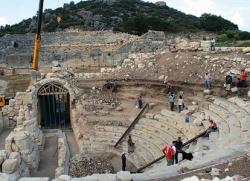 Patara - Efforts to restore the ancient parliament of the Lycian League in Antalya are nearing an end, as the headquarters of one of the most advanced republics in human history is preparing for a new opening in April 2012. The Lycian League, whose capital was Patara, was formally established in 168 B.C. under democratic principles. According to historians, the federalist union comprised 23 known city-states as members. A “Lyciarch” was elected by a senate that convened every autumn at a different city, where each member sent one, two or three representatives, depending on the city’s size, to the senate, known as the “Bouleuterion.” The major cities of the league included Xanthos, Patara, Pinara, Olympos, Myra and Tlos, whose remains are scattered throughout western Antalya. In, 1748, French philosopher Montesquieu praised the Lycian model, saying, “If one had to propose a model of an excellent federal republic, I would choose the republic of Lycia.” Later, Alexander Hamilton, one of the United States’ founding fathers, said, “Of all the confederacies of antiquity … the Lycian and Achaean leagues, as far as there remain vestiges of them, … were … those which have best deserved, and have most liberally received, the applauding suffrages of political writers.”
Patara - Efforts to restore the ancient parliament of the Lycian League in Antalya are nearing an end, as the headquarters of one of the most advanced republics in human history is preparing for a new opening in April 2012. The Lycian League, whose capital was Patara, was formally established in 168 B.C. under democratic principles. According to historians, the federalist union comprised 23 known city-states as members. A “Lyciarch” was elected by a senate that convened every autumn at a different city, where each member sent one, two or three representatives, depending on the city’s size, to the senate, known as the “Bouleuterion.” The major cities of the league included Xanthos, Patara, Pinara, Olympos, Myra and Tlos, whose remains are scattered throughout western Antalya. In, 1748, French philosopher Montesquieu praised the Lycian model, saying, “If one had to propose a model of an excellent federal republic, I would choose the republic of Lycia.” Later, Alexander Hamilton, one of the United States’ founding fathers, said, “Of all the confederacies of antiquity … the Lycian and Achaean leagues, as far as there remain vestiges of them, … were … those which have best deserved, and have most liberally received, the applauding suffrages of political writers.”
http://www.hurriyetdailynews.com/n.php?n=assembly-of-lycians-awaits-grand-opening-2011-08-28
- QATAR – Doha - An international team of Bronze Age archaeology experts has met in Doha to finalise the programme of a major conference to be held in China in November, entitled Bronze Age Societies – A Global Perspective. The Museum of Islamic Art director Aisha al-Khater welcomed the delegates and arranged for a special guided tour through the unique collections on show. “The museum tour illustrated the phenomenal breadth and diversity of a major culture expressing itself in many different forms across different periods and geographical areas,” UCL Qatar director Professor Thilo Rehren said. Prior to the discovery of iron, many societies went through a period where bronze was the main material used to make tools, weapons and ornamental objects, he explained.
There were marked differences in the way in which the Bronze Age developed in each society. Whereas China was well-known for richly decorated and complex cast ritual vessels, in Europe bronze was used primarily for daggers, tools and other more practical implements.
A major question remains as to where bronze was first invented and widely used, and Gulf countries are known to be amongst the pioneers, with the oldest known copper objects from Iran dating back more than 7,000 years.
http://www.gulf-times.com/site/topics/article.asp?cu_no=2&item_no=455077&version=1&template_id=36&parent_id=16
- FRANCE – Plaisance - Près de l'A84, la zone d'activités de Plaisance ne pourra être viabilisée qu'après des fouilles archéologiques. Un hectare est sondé depuis lundi, un autre sera « gelé » ; après la découverte d'indices sur la présence de vestiges d'habitat gaulois et médiéval, le service régional d'archéologie a décidé d'engager un complément de recherches. D'un côté il y aura une zone particulièrement sensible d'environ un hectare contenant les supposés vestiges d'habitat gaulois. « Cette zone sera mise en réserve archéologique. Autrement dit totalement gelée et entourée d'un grillage. Nous n'y toucherons pas. » D'un autre côté, la zone de vie médiévale, composée de deux parcelles distinctes (l'une de 7 000 m2 et l'autre de 2 000 m2), sera « sondée » par Archéoloire durant les deux mois à venir. « C'est un site un peu particulier du fait de la zone humide, détaille Camille Joly, archéologie spécialisée en palynologie (étude des spores, pollens fossiles, sédiments minéraux et végétaux) et directrice du laboratoire Poléa. L'environnement végétal, l'activité de vie en bordure de ruisseau ainsi que les liaisons pourraient être riches d'enseignements sur l'époque médiévale. » Et d'ajouter : « Il y a des signes forts au niveau des grains de pollen, des bois gorgés d'eau et des essences présentes ».
http://www.ouest-france.fr/actu/actuLocale_-a-Plaisance-les-fouilles-archeologiques-debutent-_-1966675------35115-aud_actu.Htm
- FRANCE – 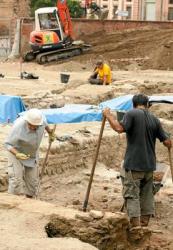 Toulouse - Le temple futuriste de l'économie toulousaine sera bâti sur les ruines d'un probable palais royal wisigoth. Les fouilles menées sous le parking de la Cité U de la fac de Droit en prévision de la construction de la Toulouse School of Economics (TSE) ont commencé au cœur de l'été. Avec déjà quelques surprises à la clé pour les archéologues de l'Inrap. Pas toujours historiques. Comme cet enchevêtrement, plus fourni que prévu, de canalisations de gaz et d'eau qui alimentaient le resto U dans les années soixante-dix. Des vestiges beaucoup plus précieux affleurent aussi à la surface du parking encaissé : les fondations de l'angle d'un bâtiment, avec un portique d'entrée de 4 mètres de large. « Nous sommes donc sûrs que ce n'est pas une maison d'habitation », indique Jean Catalo, le responsable d'opération. Il penche plutôt pour l'ultime témoignage d'une partie du palais royal des Wisigoths qui, au ve siècle, avaient fait de Toulouse leur capitale. La présence à deux pas de là d'autres vestiges de la construction retrouvés en 1992, lors des fouilles de l'église Saint-Pierre-des-Cuisines, va dans ce sens. Tout comme les matériaux utilisés : du mortier et, déjà, de la brique rose. « Les Wisigoths, bien que dits barbares, n'ont pas imposé leurs techniques de construction, ils se sont adaptés aux savoir-faire locaux », explique Jean Catalo. D'autres strates de l'histoire de la Ville rose se superposent sur cette parcelle de 2 900 m2, qui fut la frontière entre la ville antique et le bourg médiéval. Les spécialistes ont notamment retrouvé des tombes du IIIe siècle et leurs squelettes. Puis ils ont fait un bond dans le temps jusqu'aux sous-sols de l'Arsenal, où l'on fabriquait des armes de la Révolution aux années soixante.
Toulouse - Le temple futuriste de l'économie toulousaine sera bâti sur les ruines d'un probable palais royal wisigoth. Les fouilles menées sous le parking de la Cité U de la fac de Droit en prévision de la construction de la Toulouse School of Economics (TSE) ont commencé au cœur de l'été. Avec déjà quelques surprises à la clé pour les archéologues de l'Inrap. Pas toujours historiques. Comme cet enchevêtrement, plus fourni que prévu, de canalisations de gaz et d'eau qui alimentaient le resto U dans les années soixante-dix. Des vestiges beaucoup plus précieux affleurent aussi à la surface du parking encaissé : les fondations de l'angle d'un bâtiment, avec un portique d'entrée de 4 mètres de large. « Nous sommes donc sûrs que ce n'est pas une maison d'habitation », indique Jean Catalo, le responsable d'opération. Il penche plutôt pour l'ultime témoignage d'une partie du palais royal des Wisigoths qui, au ve siècle, avaient fait de Toulouse leur capitale. La présence à deux pas de là d'autres vestiges de la construction retrouvés en 1992, lors des fouilles de l'église Saint-Pierre-des-Cuisines, va dans ce sens. Tout comme les matériaux utilisés : du mortier et, déjà, de la brique rose. « Les Wisigoths, bien que dits barbares, n'ont pas imposé leurs techniques de construction, ils se sont adaptés aux savoir-faire locaux », explique Jean Catalo. D'autres strates de l'histoire de la Ville rose se superposent sur cette parcelle de 2 900 m2, qui fut la frontière entre la ville antique et le bourg médiéval. Les spécialistes ont notamment retrouvé des tombes du IIIe siècle et leurs squelettes. Puis ils ont fait un bond dans le temps jusqu'aux sous-sols de l'Arsenal, où l'on fabriquait des armes de la Révolution aux années soixante.
Les fouilles vont se poursuivre jusqu'en janvier.
http://www.20minutes.fr/article/776642/palais-wisigoth-cache-sous-arsenal
- BERMUDES – 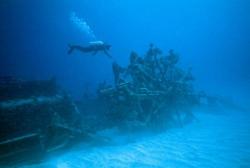
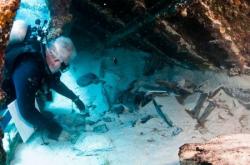 - Off Bermuda, archaeologist Jim Delgado examines fragments of a paint can found in the wreck of the paddle wheel steamer Mary Celestia, a Civil War-era blockade runner that sank 147 years ago. After storms this past winter had swept silt from the wreck, a Bermudan government expedition discovered newly exposed artifacts, including fragrance bottles and unopened—but strong-smelling—wine. On September 6, 1864, pilot John Virgin was at the helm as the Mary Celestia left the harbor at Southampton, Bermuda, which was then, as now, a British territory. The Civil War was in its third year, and the fast vessel—bound for Wilmington, North Carolina—was loaded with rifles, ammunition, and other supplies desperately needed by the Confederate States. Virgin raced the roughly 255-foot-long (68-meter-long) Mary Celestia toward the open Atlantic, only to hit rocks and reefs. Within minutes the Mary Celestia and its cargo were on the bottom of the ocean. Salvagers quickly recovered the war supplies from the smashed ship, but the bow, or front, of the wreck was soon covered with silt and lay undisturbed, some 60 feet (18 meters) down, until the recent tempests.
- Off Bermuda, archaeologist Jim Delgado examines fragments of a paint can found in the wreck of the paddle wheel steamer Mary Celestia, a Civil War-era blockade runner that sank 147 years ago. After storms this past winter had swept silt from the wreck, a Bermudan government expedition discovered newly exposed artifacts, including fragrance bottles and unopened—but strong-smelling—wine. On September 6, 1864, pilot John Virgin was at the helm as the Mary Celestia left the harbor at Southampton, Bermuda, which was then, as now, a British territory. The Civil War was in its third year, and the fast vessel—bound for Wilmington, North Carolina—was loaded with rifles, ammunition, and other supplies desperately needed by the Confederate States. Virgin raced the roughly 255-foot-long (68-meter-long) Mary Celestia toward the open Atlantic, only to hit rocks and reefs. Within minutes the Mary Celestia and its cargo were on the bottom of the ocean. Salvagers quickly recovered the war supplies from the smashed ship, but the bow, or front, of the wreck was soon covered with silt and lay undisturbed, some 60 feet (18 meters) down, until the recent tempests.
http://news.nationalgeographic.com/news/2011/08/pictures/110817-civil-war-wine-mary-celestia-shipwreck-science-bermuda-perfume/?now=2011-08-17-00:01
- ROYAUME UNI - Mons Graupius - The most northerly battle fought by imperial Rome could be left out of an inventory of Scottish battlefields due to uncertainty over the site. Mons Graupius in AD 83 or 84 saw the 9th Hispana, its cohorts and Roman cavalry defeat 30,000 Caledonians. Locations suggested in the past include Dunning in Perthshire, Carpow in Fife, Bennachie in Aberdeenshire and Culloden in the Highlands. Historic Scotland said an accurate site was needed for inclusion on its list. The body has commissioned research on Mons Graupius along with a number of other battle sites. It has already placed several battlefields including Bannockburn in 1314 and Culloden in 1746 on Scotland's Inventory of Historic Battlefields. Mons Graupius is believed to be wrapped up in the mysterious disappearance of the 9th Hispana in AD 120. The legion, cohorts of auxiliary light infantrymen from Gaul and Batavia along with cavalry were heavily outnumbered by Caledonians at the battlefield. However, the tactics of Roman general Gnaeus Julius Agricola left 10,000 tribesmen dead but relatively light casualties among the auxiliaries. In his book, Dando-Collins connects Mons Graupius with the disappearance of the 9th after it was later posted to Carlisle. He said Caledonians had sought revenge for the defeat and ambushed and slaughtered the legion along with its affiliated units. Mystery surrounding the fate of the 9th inspired Rosemary Sutcliff's children's book Eagle of the Ninth and two recent films - The Eagle and Centurion.
http://www.bbc.co.uk/news/uk-scotland-highlands-islands-14668152
- GRECE – Athènes - A sculpture depicting Zeus and Hera, king and queen of the ancient Greek pantheon of gods, has been permanently removed from the Acropolis in Athens for safe-keeping. The sculpture -- one of the last of the original decorative pieces adorning the 2,500-year-old Parthenon temple -- will be showcased in the Acropolis Museum in Athens and will be replaced by a copy. The Parthenon metope, or decorative frieze space, removed this week had been defaced by early Christians during the fall of pagan worship in Greece, and further damaged in later centuries by acid rain. Another five metopes are to removed in the coming months. The Parthenon has sustained significant damage in its long history. It was bombarded during a 17th century Venetian siege of Ottoman-held Athens and underwent modifications that turned it first into a church and then a mosque. In the early 19th century, workers employed by British ambassador Lord Elgin tore down a large number of decorative friezes from the Parthenon. They were shipped to London and were eventually put on display at the British Museum where they remain to this day. The British Museum has turned down Greek calls for their return, arguing that the Marbles are part of a world heritage and are more accessible to visitors in London.
http://www.google.com/hostednews/afp/article/ALeqM5ibVe33fh9g7kJZj1OI3tECOiSedw?docId=CNG.b8c6206079ef2416b87f96a4bc571f48.01
- INDE –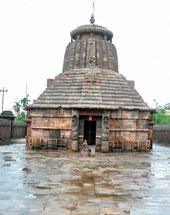
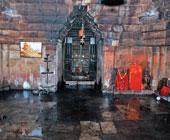 Bhubaneswar - The entrance (mukhsala) and sanctum sanctorum (garva griha) of the 12th century Megheswar temple have fallen victims to waterlogging as excess rainwater cannot find its way to the temple pond. While local residents alleged that the Shiva lingam was surrounded by knee-deep water inside the sanctum sanctorum, the condition inside the mukhsala was almost as bad. Earlier, the historical temple pond with a rich stream-like water source had an outlet towards Gangua nullah. But as a result of unplanned and unrestricted urbanisation, houses came up in the area behind the temple and the water outlet got vanished. Now, without a dedicated outlet, excess water is ruining the temple’s structure.
Bhubaneswar - The entrance (mukhsala) and sanctum sanctorum (garva griha) of the 12th century Megheswar temple have fallen victims to waterlogging as excess rainwater cannot find its way to the temple pond. While local residents alleged that the Shiva lingam was surrounded by knee-deep water inside the sanctum sanctorum, the condition inside the mukhsala was almost as bad. Earlier, the historical temple pond with a rich stream-like water source had an outlet towards Gangua nullah. But as a result of unplanned and unrestricted urbanisation, houses came up in the area behind the temple and the water outlet got vanished. Now, without a dedicated outlet, excess water is ruining the temple’s structure.
http://www.telegraphindia.com/1110829/jsp/orissa/story_14436733.jsp